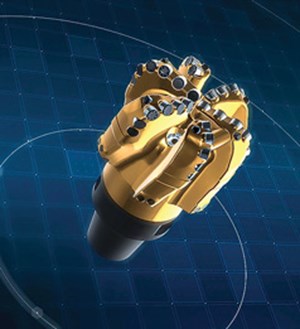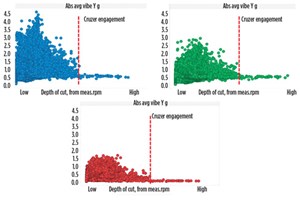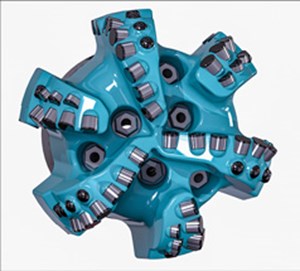Manufacturers bring new bit technologies to fruition
With continuous advances in PCD cutter technologies and further improvements in bit body stability, PDC bits have become the dominant force in worldwide drilling theaters. However, in extremely hard formations, operators still rely on roller cones to drill the most difficult hole sections to TD.
HIGH ROP PDC BIT
Rebounding oil prices have increased activity, but demand for bit technologies that reduce rig days remains unchanged. To address the requirement, Baker Hughes, a GE company, has introduced new PDC bit technologies to improve drilling efficiencies and lower well costs.
Antiwalk advances. Bit walk can add days to the drilling program in unconventional oil and gas wells, as the driller must spend considerable time sliding to get back on target. On conventional motor assemblies, sliding can account for up to 50% of drilling time, and yet only 10% to 15% of the distance drilled.
Bit walk has been mitigated traditionally by limiting operating parameters, making changes to the BHA or extending the bit’s gauge length to minimize lateral vibrations. However, these solutions do not address the challenge in wells with unplanned deviations or long laterals.
BHGE developed its Dynamus AntiWalk bit technology to deliver better directional control and stay in zone. The design incorporates an engineered gauge pad with a unique stripe that controls side cutting response using lateral depth-of-cut control, Fig. 1. This allows for better tracking to hold azimuth and inclination, resulting in increased ROP and reduced dogleg severity.
The antiwalk bit can be fitted with a wide selection of cutters, making it suitable for a range of rock formations. The Dynamus bit can be fitted with StabilisX cutters to increase ROP and reduce the WOB required for interbedded formations. And ShockWave cutters provide greater ROP and durability, with improved cuttings removal in all applications.
In the field, the new bit technology has helped operators reduce rig time by drilling with fewer course corrections that slow time to target depth. In a recent application in the Delaware basin’s Wolfcamp A shale, the antiwalk bit maintained a narrower azimuth compared to a standard drill bit, which translated to a 48% reduction in sliding time, a 33% improvement in ROP, and a savings of 47 hr in drilling time.
Avoiding stick-slip. Drilling interbedded formations can cause torsional vibrations that lead to stick-slip and impact loading. These conditions can damage the bit/BHA and reduce drilling efficiency. BHGE addressed this common challenge with its TerrAdapt feature, the first in the industry to proactively mitigate stick-slip using dynamic DOC control technology.
TerrAdapt’s adjustable feature automatically regulates DOC, based on changes in lithology, with no interaction or control from the surface. When torsional vibrations are first detected, the bit’s DOC elements extend to maintain stability. When vibrations subside, the elements retract to enable maximum ROP.
Case study. An operator working in the Austin Chalk of southeast Texas wanted to use the bit to land and complete an 8½-in. curve and lateral, using one BHA. Previous attempts resulted in a less than 20% success rate, due to inconsistent bit dulling from run to run, which led to erratic bit damage and performance. An 8½-in., six-bladed adaptive bit was used to drill 4,949 ft in 78 hr, resulting in an overall ROP of 63.4 ft/hr. Compared with wells drilled previously, the new bit saved more than 100 hr of drilling time for equivalent footage, contributing to a 150-hr reduction in the time required to complete the interval. In-bit vibration measurements verified that the bit drilled the interval with no stick-slip, and very low vibration.
DATA CAPTURE AT THE BIT
Drill bit design is based on post-run evaluation, and knowledge gained through years of application experience. The data typically used to understand the conditions that the bit encountered while drilling the interval, are taken from the surface, or, at best, above the bit, where vibrations and forces can be dampened.To fully understand what is happening in the bit, data need to be captured as close to the rock-cutting structure interface
as possible.
To solve this problem, Halliburton introduced the Cerebro electronic data capture system, which provides an unprecedented downhole view during the bit run by capturing vibration and motion data in three axes at 1,000 samples/sec continuously. The large information capture helps identify areas where damage has occurred and enables engineers to identify non-optimal performance. Identifying key limiters helps determine the difference between a bit run that is achieving performance targets and sub-optimal performance. The system also can determine the type of dysfunction, and the source, so that a proper design or parameter resolution can be applied.
Although the ultimate goal is real-time communication to the bit, recorded data can be utilized to optimize future runs. Operating parameters can be changed for similar drilling conditions, based on general guidelines, as well as the type and source of dysfunction. The operating parameters guidelines will help optimize overall field, or pad performance.
Mitigating stick-slip. It is well known that depth-of-cut control (DOCC) features will help mitigate stick-slip, and increase toolface control. But there are tradeoffs that make incorporating DOCC elements in a PDC bit design a complex process. Setting the DOCC elements too low can limit ROP. Conversely, setting the DOCC inserts too high can reduce the benefit of the feature.
Without access to continuous high-speed data in the bit, proper setting of DOCC height is based on intuition and performance clues from surface data, which may subjectively indicate a specific bit run has sub-optimal ROP, but exceptional toolface control. However, by using the high-speed data provided by the Cerebro system, an acceptable level of stick-slip can be identified, to determine the optimum height setting and performance expectations.
North American case study. On a recent set of runs in North America, vibration and motion data were recorded to better understand performance results on several horizontal wells. The curve interval was drilled utilizing standard directional PDC bits, as applied on previous runs. However, the case study bits were equipped with Cruzer DOCC elements that roll on the bottom of the hole. The smooth rolling action does not increase friction and/or torque, thereby allowing that energy to be utilized by the PDC cutting structure. The elements were set at a DOC of 0.15 in./rev, which, at the parameters used, allowed for engagement at a higher ROP.
The data showed that as DOC increased, vibration severity generally decreased, to the point at which the DOCC elements started to engage, Fig. 2. The data indicated that vibration peaked at about 0.050 in./rev, meaning that above this DOC, the run benefited from softer formations, resulting in higher ROPs without the damaging vibration. Secondly, the data showed that the Cruzer elements were extremely efficient at controlling DOC.
SCULPTED CUTTERS
Although shaped PDC cutters have been on the market for several years, they are now being used in more applications because of advancements in cutter-rock interaction modeling and manufacturing technology. National Oilwell Varco (NOV) has developed a line of 2D and 3D shaped cutters, in its ReedHycalog business unit, Fig. 3.
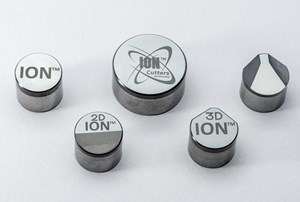
The two application-based geometries are combined with the company’s cutter technology and enhanced with latest leaching techniques, to drive performance improvements. The 2D cutters are designed for shale applications. The chamfer reduces the contact surface between the cutters and acts as a flow channel, directing the fluids toward the interface to help break ribbons of drilled formation that can lead to bit balling. The 3D cutters are manufactured with a chisel-shaped tip that increases stress concentration on the rock to enhance fracture initiation and propagation.
ION 4D. Using the results from field trials, NOV launched an engineering initiative to implement new shaped cutters. The goal was to build on the proven advantages of previous cutters, while delivering a new element suitable for a wider-range of applications. The program produced ION 4D cutters, which have a chisel-shaped tip, combined with a non-planar face geometry, which gradually transforms from a point on the tip to a large chamfer on the non-cutting side.
Laboratory testing. A full-scale pressurized drilling apparatus was used to test the cutters in simulated in-situ conditions on Torrey Buff sandstone, Carthage Marble, and halite. The results indicated that for the same WOB, the 4D cutters have the potential to improve ROP in salt by 61% and reduce MSE by 20%. In addition, ROP improvements in the other three rock types were between 29% and 40%.
Field testing. A vertical test was run in Pinedale, Wyo., in an interbedded formation consisting of sand/limestone, shale/salt, with compressive strength ranging between 10 and 30 ksi. A six-bladed 8¾-in. bit, with ION 4D cutters, drilled 1,974 ft at an average ROP of 160.9 ft/hr. This performance was 45% faster than the average offset ROP of 111.3 ft/hr and 15% higher ROP than the fastest offset run, regardless of bit design.
Williston basin case study. In another well, 4D cutters were tested in the cone area of an 8¾-in. Tektonic six-bladed bit, which was used to drill 6,525 ft of vertical section through interbedded sand/siltstone, shale, halite and various carbonate. The bit reached TD and averaged 191.9 ft/hr. The run was 7% faster than the offset, saving 2 hr of rig time.
Two additional test runs occurred in the Powder River basin, Wyo. Both tests were done using the same five-bladed Tektonic bit with ION 4D cutters. In a lithology of mainly sand/shale, one of the bits drilled 7,149 ft at 397.2 ft/hr to complete the section in 18 hr. The ROP for the run was 25% above the rig’s offset average. In another well, the bit only needed to drill 4,301 ft to complete the interval at an ROP of 623 ft/hr, which was 13% above the rig’s offset average.
IMPROVED CRUSHING ACTION
The Xplorer Helix spiral TCI configuration is the latest innovation for Xplorer premium roller cone drill bits from Smith Bits, a Schlumberger company. The spiral layout of the TCI inserts improves ROP 20% to 50%. The staggered configuration means that the inserts provide better bottomhole coverage, which increases rock-crushing efficiency. Conventional cutting structures feature concentric rows of inserts that lead to ridges of rock, causing the bit to track into the grooves. The Xplorer Helix configuration is designed to counteract tracking by staggering the inserts in a spiral
array, Fig. 4.
Case study. Kuwait Oil needed to drill a vertical 28-in. section from 500 ft to 5,000 ft MD through interbedded soft/hard carbonates and shale layers. While drilling the formations, with UCS values ranging from 6,000 to 24,000 psi, the bit suffered impact-induced TCI cutter damage, which led to decreased ROP. Additionally, the section was very long, which meant that seal and bearing life were an important aspect for the design.
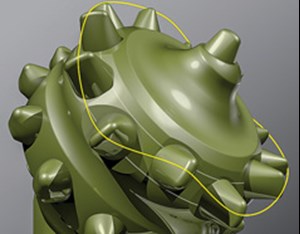
To solve the issues, the operator needed to maintain a sharp cutting structure and seal/bearing integrity, so that the section could be drilled in one trip. An Xplorer bit with Xplorer Helix configuration was selected for the project, due to the bit’s arrays of staggered carbide inserts that can endure impact and can drill the section to TD in one trip. The bit was run and achieved an ROP 107% greater than the fastest ROP in the field in similar applications. This resulted in saving a total of four drilling days.
Collaborative approach. An operator in the Permian basin recognized the need to further reduce drilling time and well operating costs when drilling the curved portion of the wellbore. A relatively simple approach could have been deploying an off-the-shelf cutter to see whether it would work. However, the operator decided to pursue a collaborative business model by engaging directly with the service provider to find an optimal solution.
Drill bit experts from the Schlumberger Customer Performance Center worked directly with the operator to understand specific issues associated with drilling the curve. The collaborative approach consisted of two main components:
- A thorough review of operating parameters and outcome-based metrics for measuring drilling performance in the curved interval.
- Analysis of a large drilling bit run database, to develop a technical solution that would not have been considered otherwise.
Using the IDEAS platform to simulate downhole bit behavior, experts identified a PDC bit technology that had been developed for drilling curves in the Eagle Ford and Marcellus plays. Given the unique drilling challenges in the Permian basin—specifically maintaining smooth tool face control—it was determined that a rapid cutting structure modification would meet steerability targets and drill the entire curve interval in less than 20 hr.
The fit-for-purpose solution combined a pre-existing design with the DOC features, additional backup cutters and modified gauge pad configuration. The operator field-tested the solution in Reeves and Pecos counties, Texas, and the new cutting structure increased ROP by 30%, with a 36% reduction in drilling time.
HARD ROCK PDC BITS
Modern drilling practices in hard rock and transition zones require a PDC bit to withstand higher drilling parameters, particularly increased WOB.
To meet the challenge, Ulterra Drilling Technologies has developed the XP product line, using sophisticated design techniques, high-quality materials, and advanced manufacturing processes, Fig. 5. The XP series is based on a bit body engineered to ensure structural integrity under extreme drilling conditions. This level of design allows the bit to withstand more demanding drilling parameters, including greater WOB, without sacrificing ROP. Along with high structural integrity, the bits’ cutter positioning and force balancing are both optimized for reduced tangential overload, to deliver maximum stability under high-energy inputs. This allows the best performance in challenging drilling environments.
As drilling information is acquired, Ulterra’s unique rapid design and prototyping process quickly optimizes each design, enabling operators to improve drilling performance from well to well.
New Mexico case study. Drilling for a major operator in the northern Delaware basin, a 97/8-in. XP616 bit achieved back-to-back 24-hr footage records. In the first well, the XP616 drilled 5,737 ft in one day as part of a 6,800-ft vertical section, resulting in an average 24-hr ROP of approximately 240 ft/hr. This was the most footage drilled by a 97/8-in. bit in a 24-hr period in the Permian basin.
Three weeks later, on the next well for the same operator, the same XP616 beat its own record, drilling 6,231 ft of hole section in a 24-hr period, as part of a 6,560-ft vertical section, while averaging 260 ft/hr. This single bit effectively drilled 2¼ mi of hole section in 48 hr, setting back-to-back Permian basin footage records.
SHAPED CUTTER TECHNOLOGY
The ability to fine-tune a bit’s interaction with a formation is producing unique PDC bit cutter geometries that are improving drilling performance. Experience in the Permian basin, Oklahoma STACK and Canadian laterals, using a variety of shaped cutters, has resulted in significant gains in ROP and total footage drilled.
FORCE shaped cutter technology, developed by Varel Oil & Gas Drill Bits, has produced four shaped cutter geometries that match cutting action to drilling conditions and objectives. The OVAL, TRIFORCE, SCOOP and FANG cutters feature raised ridges, concave faces, and other non-standard geometries, Fig. 6. Each shape provides a different cutting action to reduce torque, pre-fracture the rock, create a progressive backrake, and enable non-standard positioning on the bit.
The cutters were developed by proprietary capabilities in integrated design, modeling, and realistic laboratory testing that make it possible to quickly and efficiently explore new options. Pioneering research is yielding insights into cutters and how they interact with various formations. The relatively fast and reliable R&D cycle reduces the time, costs and risks of a traditional learning curve that is dependent on multiple field runs.
Moving quickly from concept to field application means new options for increasing ROP and footage drilled can be explored easily. The success of the process and resulting cutters validates an increasing use of custom designs to improve performance.
Field performance. In challenging applications, FORCE shaped cutters has resulted in performance advantages versus conventional planar geometries.
OVAL cutters improved ROP when drilling long, S-curve trajectories in Guatemalan wells. In initial runs, bits equipped with the cutters more than doubled ROP in a medium-hard formation. As the oval shape wears, it presents a smaller contact point, which produces more force with the same weight on bit. The cutters allowed a tighter cutter placement and more efficient cutting action with less reactive torque for better directional control.
SCOOP cutters enhanced penetration rates in West Texas’ Delaware basin. The concave cutters produce a variable backrake and as the cutter shears deeper into the rock, the face presents a progressively higher effective backrake. The resulting increase in efficiency achieves greater ROP for an equivalent WOB.
The first regional run of a PDC bit equipped with the concave cutters drilled the lateral in the Bone Spring formation’s shaley sand at 233.4 ft/hr, compared to an offset average of 177.6 ft/hr. The prototype cutters also resulted in similar performance in the fine-grained sandstone, shale and conglomerate of Oklahoma’s Owego formation.
TRIFORCE cutters feature a ridged profile that concentrates force on a small leading edge to fracture and plow through the rock. For the same amount of travel, the cutter removes a higher volume of rock to produce higher ROP. The cutters were used initially in the Delaware basin to drill carbonates, shale and sandstone. The first-generation prototypes had good performance and drilled 5,932 ft at 73.7 ft/hr. A second run in an Oklahoma STACK well drilled through interbedded sands, limestones and shales approximately 3.2% further than the average offset, and ROP was 70% higher than the average of all offsets and similar to other bits with raised profile cutters.
FANG cutters are scribe-type cutters that are uniquely positioned on the cutting structure. In a STACK well, placing scribe cutters in patented interruptive, secondary positions yielded performance gains, drilling 32.3% above the average footage with 53.8% higher ROP. ![]()

- Applying ultra-deep LWD resistivity technology successfully in a SAGD operation (May 2019)
- Adoption of wireless intelligent completions advances (May 2019)
- Majors double down as takeaway crunch eases (April 2019)
- What’s new in well logging and formation evaluation (April 2019)
- Qualification of a 20,000-psi subsea BOP: A collaborative approach (February 2019)
- ConocoPhillips’ Greg Leveille sees rapid trajectory of technical advancement continuing (February 2019)

